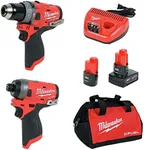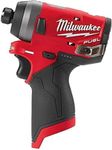Buying Guide for the Best Milwaukee Impact Driver
When choosing an impact driver, it's important to consider the tasks you plan to tackle and the features that will best support those tasks. Impact drivers are powerful tools designed to drive screws and bolts with high torque, making them ideal for heavy-duty applications. Understanding the key specifications will help you select a model that fits your needs, whether you're a professional tradesperson or a DIY enthusiast.TorqueTorque is the rotational force that the impact driver can apply. It's crucial because it determines how effectively the tool can drive screws and bolts into various materials. Torque is usually measured in inch-pounds (in-lbs) or Newton-meters (Nm). Lower torque (around 800-1000 in-lbs) is suitable for light tasks like assembling furniture, while higher torque (over 1500 in-lbs) is better for heavy-duty tasks like driving large screws into dense wood. Consider the types of projects you will be working on to determine the appropriate torque level.
Speed (RPM)Speed, measured in revolutions per minute (RPM), indicates how fast the driver can rotate. This is important because higher speeds can drive screws faster, which is useful for repetitive tasks. Impact drivers often have variable speed settings, allowing you to adjust the speed based on the task. Lower speeds (around 1000 RPM) are better for precision work, while higher speeds (up to 3000 RPM) are ideal for fast driving. Choose a model with speed settings that match your typical work pace and precision needs.
Impacts Per Minute (IPM)Impacts Per Minute (IPM) measures how many times the driver delivers its hammering action in a minute. This is important for driving screws into hard materials, as more impacts can help overcome resistance. Lower IPM (around 2000) is sufficient for softer materials, while higher IPM (up to 4000) is better for tougher materials like metal or hardwood. Consider the materials you frequently work with to decide on the necessary IPM.
Battery VoltageBattery voltage affects the power and runtime of a cordless impact driver. Higher voltage batteries (18V or 20V) provide more power and are suitable for demanding tasks, while lower voltage batteries (12V) are lighter and more compact, ideal for less intensive work. If you need a balance between power and portability, consider the types of projects you will be doing and how long you need the tool to run on a single charge.
Weight and ErgonomicsThe weight and ergonomics of an impact driver affect how comfortable it is to use, especially for extended periods. Lighter models are easier to handle and reduce fatigue, which is important for overhead or repetitive tasks. Ergonomic designs with comfortable grips can also enhance control and reduce strain. Consider how long you typically use the tool and the types of positions you work in to choose a model that feels comfortable and balanced in your hand.
Chuck SizeThe chuck size determines the size of the bits that the impact driver can accommodate. Most impact drivers have a 1/4-inch hex chuck, which is standard for most driving tasks. However, some models may offer different sizes or quick-change chucks for convenience. Consider the types of bits you already own or plan to use to ensure compatibility with the chuck size of the impact driver you choose.













